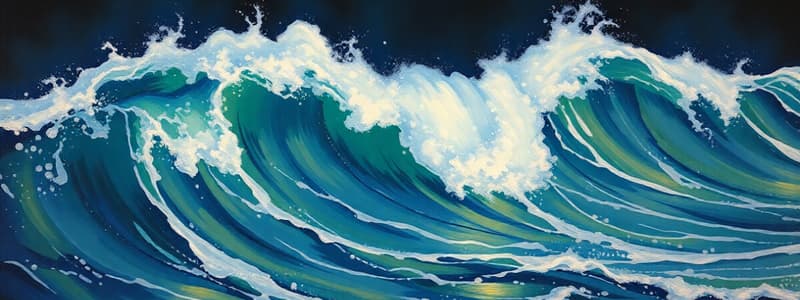Podcast
Questions and Answers
What is the relationship between wave speed, frequency, and wavelength?
What is the relationship between wave speed, frequency, and wavelength?
- Wave speed equals the product of frequency and wavelength. (correct)
- Wave speed is the product of frequency and amplitude.
- Wave speed is equal to frequency divided by wavelength.
- Wave speed is the sum of frequency and wavelength.
Which of the following describes a transverse wave?
Which of the following describes a transverse wave?
- Particles remain stationary while the wave moves.
- Particles oscillate in a circular motion.
- Particles oscillate parallel to the direction of energy transfer.
- Particles oscillate perpendicular to the direction of energy transfer. (correct)
What is amplitude in the context of waves?
What is amplitude in the context of waves?
- The maximum displacement of a particle from its rest position. (correct)
- The speed of the wave motion.
- The distance between two adjacent wavefronts.
- The time taken for one complete oscillation.
How is the intensity of a wave defined?
How is the intensity of a wave defined?
What does the period of a wave represent?
What does the period of a wave represent?
Which of the following units is used to measure frequency?
Which of the following units is used to measure frequency?
What is the primary characteristic of stationary waves?
What is the primary characteristic of stationary waves?
In a displacement-distance graph for a wave, what does the wavelength represent?
In a displacement-distance graph for a wave, what does the wavelength represent?
What happens to the speed of a wave as its frequency increases, assuming the wavelength remains constant?
What happens to the speed of a wave as its frequency increases, assuming the wavelength remains constant?
What unit is used to measure wave speed?
What unit is used to measure wave speed?
Flashcards are hidden until you start studying
Study Notes
Progressive Waves
- Progressive waves transfer energy.
- Transverse waves: Particle oscillation is perpendicular to the wave energy direction
- Longitudinal waves: Particle oscillation is parallel to wave energy direction
Wave Characteristics
- Amplitude (A): The maximum displacement of a particle from its rest position. The unit is meters (m).
- Wavelength (λ): The distance between two adjacent wavefronts. The unit is meters (m).
- Frequency (f): The number of complete oscillations of a particle in the wave per unit time. The unit is Hertz (Hz).
- Period (T): The time taken for one complete oscillation. The unit is seconds (s).
Wave Speed
- Wave speed (v): The distance moved by the wave in a given time.
- Formula: v = λ/T = fλ
- The unit is meters per second (m/s).
Intensity
- Intensity: The rate of energy transmitted (power) per unit area at right angles to the wave velocity.
Stationary Waves
- Stationary waves are formed by the superposition of two progressive waves of the same frequency traveling in opposite directions.
- They do not transfer energy.
- They have fixed points called nodes where the amplitude is zero.
- They have points of maximum amplitude called antinodes.
Difference Between Progressive and Stationary Waves
- Progressive waves transfer energy.
- Stationary waves do not transfer energy.
Energy of a Wave
- Waves possess energy.
- The amount of energy a wave carries depends on its frequency and amplitude.
Studying That Suits You
Use AI to generate personalized quizzes and flashcards to suit your learning preferences.




